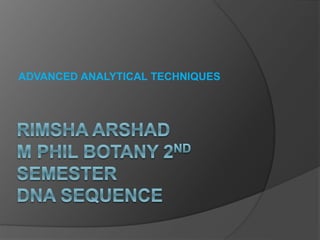
SIR WASIQ dna sequence ppt.pptx
- 2. DNA Sequencing is the method that determines the order of the four nucleotides bases (adenine, thymine, cytosine, and guanine) that make up the DNA molecule and convey important genetic information. In the DNA double helix, the four bases bond with the specific partner to form units called base pairs (bp). Adenine (A) pairs with thymine (T) and cytosine (C) pairs with guanine (G). The human genome contains around 3 billion base pairs that provide the instructions for the creation and maintenance of a human being
- 3. DNA Sequencing Methods Sanger sequencing was discovered by English biochemist Frederick Sanger in the 1970s. Sanger method is a classical DNA sequencing method that utilizes fluorescent ddNTPs (dideoxynucleotides, N = A, T, G, or C) to prevent the addition of another nucleotide Next-generation sequencing (NGS, also known as massively parallel sequencing) technologies have largely supplanted Sanger sequencing with advantages such as high throughput, cost efficiency, and rapidness. NGS can determine the order of millions of fragments simultaneously. NGS is a short-read sequencing that requires the construction of small fragment library, followed by deep sequencing, raw data preprocessing, DNA sequence alignment, assembly, annotation, and downstream analysis
- 4. Emerging third-generation sequencing, also known as long-read sequencing can examine billions of templates of DNA and RNA and simultaneously detect variable DNA methylations without biased. Applications of DNA Sequencing Technologies DNA sequencing reveals the genetic information that is carried in a particular DNA segment, a whole genome or a complex microbiome. Scientists can use sequence information to determine which genes and regulatory instructions are contained in the DNA molecule. The DNA sequence can be screened for characteristic features of genes, such as open reading frames (ORFs) Homologous DNA sequences from different organisms can be compared for evolutionary analysis between species or populations. Notably, DNA sequencing can reveal changes in a gene that may cause a disease.
- 5. DNA sequencing has been used in medicine including diagnosis and treatment of diseases and epidemiology studies. Sequencing has the power to revolutionize food safety and sustainable agriculture including animal, plant and public health, improving agriculture through effective plant and animal breeding and reducing the risks from disease outbreaks. Additionally, DNA sequencing can be used for protecting and improving the natural environment for both humans and wildlife
- 6. History of DNA Sequencing James Watson and francis crick published the first description double –helix DNA structure in 1953. Early sequencing was performed with tRNA through a technique developed by Richard Holley , who published the first structure of a Trna in 1964. The sequencing of DNA molecules began in the 1970s with development of the Maxam-Gilbert ethod,and later the sanger method.
- 7. 1972 – Earliest nucleotide sequencing – RNA sequencing of Bacteriophage MS2 by WALTER FIESERR. Originally developed by Frederick Sanger in 1975, most DNA sequencing that occur in medical and research laboratories today is performed using sequencers employing variations of the sanger method. 1997 – DNA Sequencing FREDERICK SANGER by chain termination method.
- 8. Chemical degradation method by ALLAN MAXAM and WALTER GILBERT. 1977 First DNA genome to be sequenced of Bacteriophage x174. 1986 LOREY and SMITH gave semi automated sequencing . 1987- Applied biosystems marketed fully automated sequencing machines. 1995 CRAIG VENTER, HALMILTON SMITH and collegues published first complete genome sequence of Haemophilus influenzae. 2003 – humen genome project .